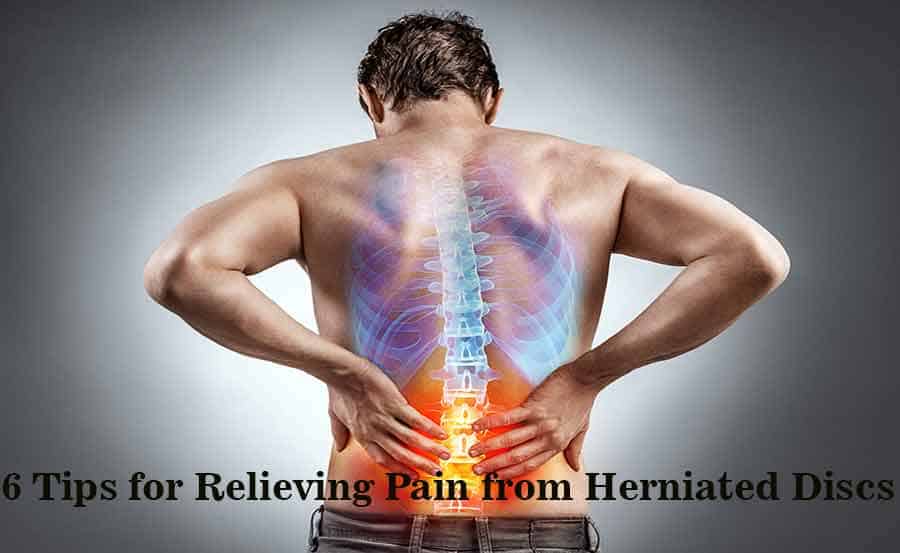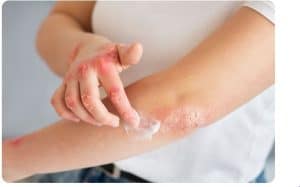
Man holding back with painful spine highlighted in red, woman with neck pain holding her neck, woman receiving a shoulder massage, woman performing a plank with professional guidance, picture representing incorrect versus correct standing posture, physical therapist treating a patient with back pain
The discs between your backbones absorb shock, so it’s no surprise that many people feel lower-back or neck pain when the jelly-like interior of a disc pushes through the hard exterior and presses on nearby nerves.
A herniated disc (also called slipped, bulging, or ruptured disc) is sometimes so severe that you may miss work or special events. If a herniated disc is not properly treated, it can harm your overall quality of life by preventing you from participating in special activities and performing certain daily tasks.
Luckily, it is not difficult to achieve herniated disc pain relief with the right support and treatment plan. Follow these 6 all-natural, pill-free tips for alleviating herniated disc pain:

Table of Contents
Tip #1: Reduce Inflammation, ASAP
Consider this tip step 1 of your treatment plan. Within the first two days of noticing pain, try to eliminate as much inflammation as possible. Inflammation will worsen the symptoms and add more pressure on the surrounding nerves.
Certain medications such as non steroidal anti-inflammatory can help reduce inflammation, but if you want to ditch the potential side-effects of pills, an ice pack will lessen the inflammation.
Apply the ice pack several times a day for no more than 20 minutes at a time. Do not heat the injured area for the first couple of days since heating too soon after the injury can increase the inflammation.
Rest as much as possible the first couple of days post-injury. Do not perform stretches, strengthening exercises, or massage during the first 72 hours of injury because these activities will aggravate the herniated disc during this initial injury phase.
Tip #2: Heal it with Heat
After a couple of days focused solely on icing and resting, it is time to increase blood circulation in the injured area by using a heating device/pad.
Bringing blood flow back to the area after reducing the inflammation can soothe muscle spasms, enhance flexibility, and encourage healing nutrients to enter the injured area.
Try a combination of moist and dry heat to see which feels better. Electric heating pads, heated blankets, hot baths, saunas, and gel heating packs are some of the most effective ways of heating the hurt area.
Tip #3: Ease Tension with Massage or Manual Therapy
Muscles usually stiffen with pain and inflammation, so you might feel instant relief from massage or manual therapy.
Foam rolling may help ease tension in the back and an electric massaging device may help relieve stiffness in the neck; however, seeing a physical therapist that performs massage and manual therapy is more effective.
A physical therapist that is trained in manual therapy for spinal injuries can find the trigger points and perform deep tissue massage. The most advanced physical therapists can also mobilize stiff joints to bring immediate pain relief to the patient.
Tip #4: Treat the Underlying Issue with Targeted Exercises
Most herniated discs are a result of underlying issues such as weak muscles, poor flexibility, and incorrect posture.
Focus on core-strengthening exercises such as planks if your disc herniation is in the lower back. Avoid crunches as the movement can irritate the back.
If the herniated disc is in your neck, try exercises (such as chin tucks) that strengthen the muscles surrounding the neck area.
Stretching and rotation exercises will improve flexibility if your herniated disc was the result of poor flexibility.
Consider visiting a physical therapist for a complete stretching and strengthening program. Physical therapists will provide you with the best types of exercises for your condition and ensure that you’re performing these exercises correctly.
Tip #5: Fix Your Posture
Poor posture is one of the leading causes of many physical injuries, including herniated discs. If you sit, stand, lift, and exercise with incorrect posture, you are bound to suffer unwanted consequences.
When standing, you should be able to draw an imaginary straight line down the center of your body from your head to the soles of your feet.
When sitting, plant your feet flat on the ground. Sit “tall” with your chin tucked in and your back against the chair. Place a rolled towel between your chair and the curve in your lower back if needed for extra support. If you are using a laptop, make sure it is at eye-level so that you are looking straight ahead.
When lifting, always bend at the hips and knees to squat before picking up the object. Never crouch or bend forward to pick up a heavy object. Lift using the muscles in your legs rather than the muscles in your back. Avoid twisting while picking up and carrying a heavy object.
Tip #6: Still in Pain? Visit a Physical Therapist
If home treatments did not help (or if they only helped for a short amount of time), consider visiting a physical therapist who specializes in the spine. A physical therapist can treat the cause of your injury to prevent the symptoms from returning.
Physical therapists can heal herniated discs through a variety of safe techniques such as stretching, mobilization exercises, massage, strengthening exercises, and spinal manipulation.
Patients who follow a physical therapy program for a herniated disc are less likely to suffer from reoccurring injuries that are caused by problems such as weak muscles, poor flexibility, and lack of mobility.
Do You Need Relief, ASAP? Our Expert Team of Physical Therapists Can Help
Our team of physical therapists at Back in Motion Sport and Spine Physical Therapy are trained to treat spine conditions such as herniated discs.
Click here to inquire about our awarded physical therapy program or to make an appointment.


